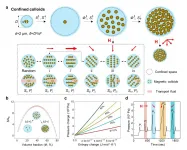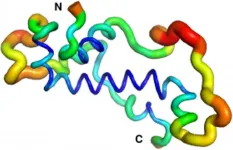Using AI to assess surgical performance
2021-03-12
(Press-News.org) More than one million operations are performed in Switzerland every year. A surgeon's skill has a direct impact on the outcome of the operation. Training and experience, as well as momentary fatigue and other influencing factors all play a role. At present, skill is tested by experts, either directly during an operation or by evaluating video footage. This approach is very costly and only a limited number of experts are available. Moreover, the assessment may vary and is not always fully reproducible. For some time, attempts have been made to automate and objectify the assessment of surgeons' skills.
Proof of feasibility
The key result of the study is the proof of the fundamental feasibility of an artificial intelligence (AI)-based assessment of a surgeon's skill in the context of a surgical procedure. The AI used in the study identified good or moderate surgical skill with 87 percent accuracy. This can be considered a very good finding. Lead author Joël Lavanchy explains: "What was surprising was the high degree of algorithms' accuracy with the selected method. Our method of assessing surgical skills is based on the analysis of instrument movement. Surgical instruments were identified using computer algorithms and their movement was analyzed during the time period."
Innovative, three-stage approach with AI
The research team used a newly developed, three-stage approach. The study was based on 242 videos of laparoscopic gallbladder removal procedures. The first step was to identify the instruments used. For this purpose, a convolutional neural network (CNN) was trained to recognize the instruments. In the second step, the movements were analyzed, and their patterns were extracted. In the third step, the extracted movement patterns correlated with rating results by experts using linear regression.
Broader database and in-depth training of algorithms is needed
The present study is an important first step towards assessing surgical performance. More in-depth steps are needed before the technology can be used in clinical practice. For one thing, the AI algorithms need to be trained on a broader database to further improve instrument recognition. For another thing, additional surgeries need to be investigated and, in the medium term, videos of open surgeries as well as procedures apart from the abdominal area can be addressed.
Dr. Enes Hosgor, a co-author of the study who leads the AI division at caresyntax, a medical technology company headquartered in Berlin and Boston, classifies the results as follows: "AI has mainly been used thus far to identify instruments or specific surgical phases. In our study, we now assess surgical skill based on surgical videos. In the future, the use of AI can solve problems at multiple levels: it is available on-demand peri-operatively (not dependent on a few hard-to-find experts); it is objective using algorithm-driven standards; it is comparable at a transregional level as well as surgeon level and could thus provide important support for decision-making processes at certification institutes."
AI at medical location in Bern: CAIM as an opportunity
The project provides an important indication of the future development of the use of AI in medicine. In the future, it will shift from the erstwhile evaluation of image material to the provision of expert systems. Prof. Guido Beldi, head of the study, clarifies: "The study is a first step. Now that we have demonstrated the fundamental feasibility, we can start planning assistance systems that will support surgeons during operations. For example, they will be alerted when fatigue is detected, thereby helping to prevent complications."
INFORMATION:
The promotion of AI at the Bern medical center will contribute to its further development when the Center for Artificial Intelligence in Medicine (CAIM) opens here on March 19.
ELSE PRESS RELEASES FROM THIS DATE:
2021-03-12
Colloidal suspensions of microscopic particles show complex and interesting collective behaviors. In particular, the collective dynamics of colloids is fundamental and ubiquitous for materials assembly, robotic motion, microfluidic control, and in several biological scenarios. The collective dynamics of confined colloids can be completely different from that of free colloids: for instance, confined colloids can self-organize into vortex structures, coherent motion, or different phase behaviors. On one hand, due to the complexity of colloidal suspensions, how to finely tune the ...
2021-03-12
As the world continues to grapple with the COVID-19 pandemic, an international team of researchers have published a review of the best techniques to collect airborne aerosols containing viruses.
In the review, which was published by the Science of the Total Environment journal, a team led by the University of Surrey concluded that the most effective way to collect and detect airborne pathogens, particularly viruses, was to use cyclone sampling techniques.
For example, the sampler draws the air through the cyclone separator. It then uses centrifugal forces to collect the particles on a sterile cone containing the liquid collection vessel, such as DMEM (Dulbecco's minimal essential ...
2021-03-12
Photovoltaics decisively contributes to sustainable energy supply. The efficiency of solar cells in directly converting light energy into electrical energy depends on the material used. Metal-halide perovskites are considered very promising materials for solar cells of the next generation. With these semiconductors named after their special crystal structure, a considerable increase in efficiency was achieved in the past years. Meanwhile, perovskite solar cells have reached an efficiency of up to 25.5 percent, which is quite close to that of silicon ...
2021-03-12
Proteins are the key component in all modern forms of life. Haemoglobin, for example, transports the oxygen in our blood; photosynthesis proteins in the leaves of plants convert sunlight into energy; and fungal enzymes help us to brew beer and bake bread. Researchers have long been examining the question of how proteins mutate or come into existence in the course of millennia. That completely new proteins - and, with them, new properties - can emerge practically out of nothing, was inconceivable for decades, in line with what the Greek philosopher Parmenides said: "Nothing can emerge from nothing" (ex nihilo nihil fit). Working with colleagues from the USA and ...
2021-03-12
The Cabeza de los Gatos waste rock pile, left from mining activities in the town of Tharsis (Huelva), underwent a rehabilitation process consisting of remodelling the slope of the pile, applying liming materials and then a layer of soil. Finally, trees and shrubs typical of the area were planted and a hydroseeding with a mixture of shrub and herbaceous seeds was applied. Twelve years later, a study led by researchers from IRNAS-CSIC, in collaboration with Sabina Rossini Oliva, a researcher from the University of Seville and the Environment and Water Agency of Andalusia (AMAYA), has proven the effectiveness of this sort of rehabilitation.
"The results obtained show that the steps taken were successful. Now, ...
2021-03-12
People with high levels of emotional intelligence are less likely to be susceptible to 'fake news', according to research at the University of Strathclyde.
The study invited participants to read a series of news items on social media and to ascertain whether they were real or fictitious, briefly describing the reasons for their answers. They were also asked to complete a test to determine their levels of emotional intelligence (EQ or emotional quotient) and were asked a number of questions when considering the veracity of each news item.
Researchers found that those who identified the types of news correctly were most likely to score highly in the EQ tests. There was a similar correlation between correct identification and educational attainment.
The ...
2021-03-12
In asthma, the airways become hyperresponsive. Researchers from Uppsala University have found a new mechanism that contributes to, and explains, airway hyperresponsiveness. The results are published in the scientific journal Allergy.
Some 10 per cent of Sweden's population suffer from asthma. In asthmatics, the airways are hyperresponsive (overreactive) to various types of stimuli, such as cold air, physical exertion and chemicals. The airways become constricted, making breathing difficult.
To diagnose asthma, a "methacholine test" is commonly used to determine whether a person is showing signs of airway hyperresponsiveness. Methacholine binds to what are known as muscarinic receptors in the smooth muscle cells lining the inside ...
2021-03-12
The researchers say this is a big step in tackling smouldering peat fires, which are the largest fires on Earth. They ignite very easily, are notoriously difficult to put out, and release up to 100 times more carbon into the atmosphere than flaming fires, contributing to climate change.
The fires, known as 'zombie fires' for their ability to hide and smoulder underground and then reanimate as new flames days or weeks after the wildfire had been extinguished, are prevalent in regions like Southeast Asia, North America, and Siberia.
They are driven by the burning of soils rich in organic content like peat, which is a large natural reservoir of carbon. Worldwide, peat fires account for millions of tonnes of carbon released into the atmosphere each year.
Firefighters currently use millions ...
2021-03-12
A new model of aging takes into account not only genetics and environmental exposures but also the tiny changes that randomly arise at the cellular level.
University Professor Caleb Finch introduced the "Tripartite Phenotype of Aging" as a new conceptual model that addresses why lifespan varies so much, even among human identical twins who share the same genes. Only about 10 to 35 percent of longevity can be traced to genes inherited from our parents, Finch mentioned.
Finch authored the paper introducing the model with one of his former graduate students, Amin Haghani, who received his PhD in the Biology of Aging from the USC ...
2021-03-12
Researchers at Lund University in Sweden can now show that a new examination method identifies high-risk plaques in the blood vessels surrounding the heart, that cannot be seen solely with traditional angiograms. This type of plaque, rich in fat, could potentially cause recurring heart attacks in patients with heart disease. The study is published in the The Lancet.
"We have been working on this study for ten years. This creates a unique opportunity to treat plaques before they cause a heart attack", says David Erlinge, professor of cardiology at Lund University and Consultant in ...
LAST 30 PRESS RELEASES:
[Press-News.org] Using AI to assess surgical performance




